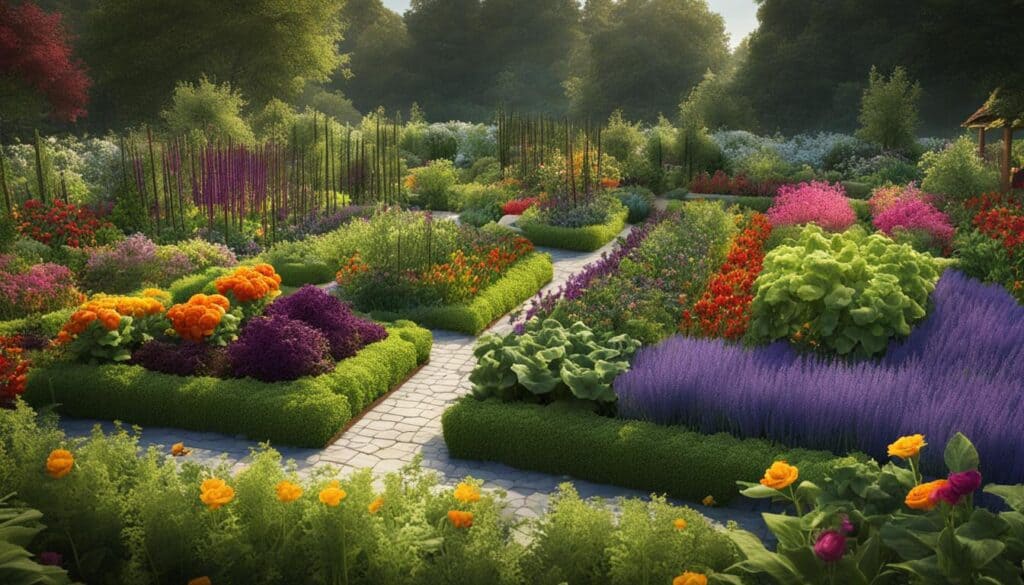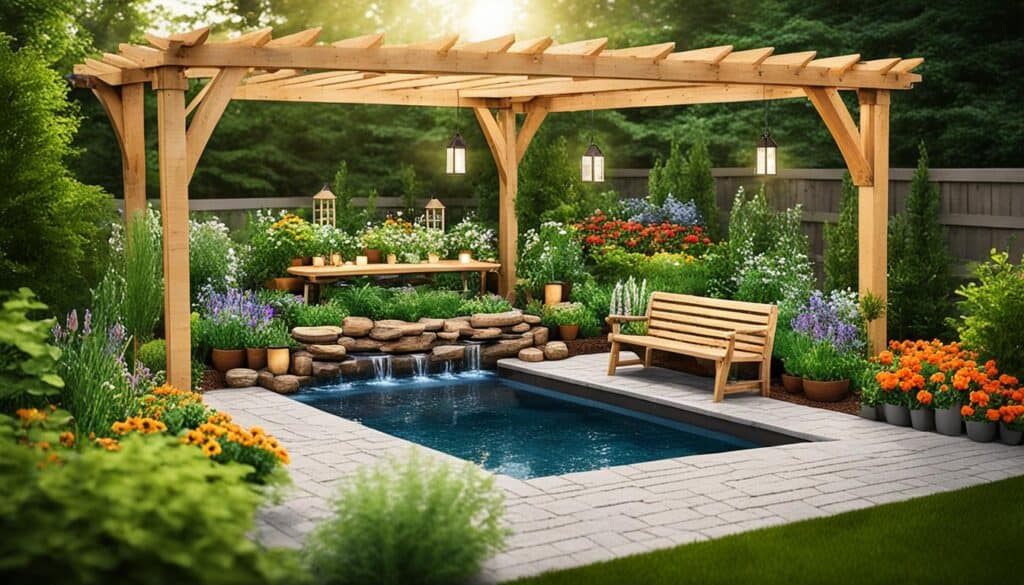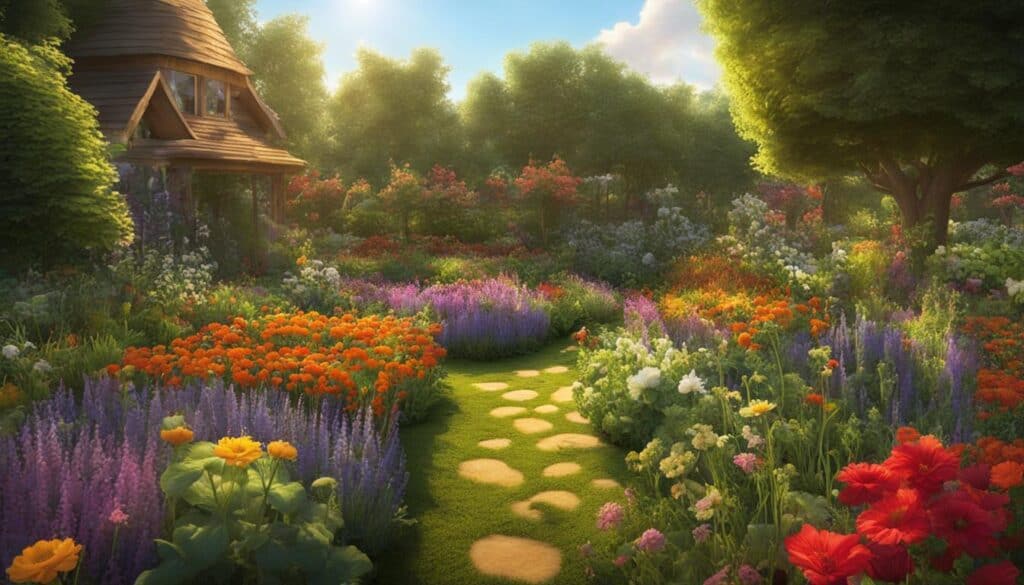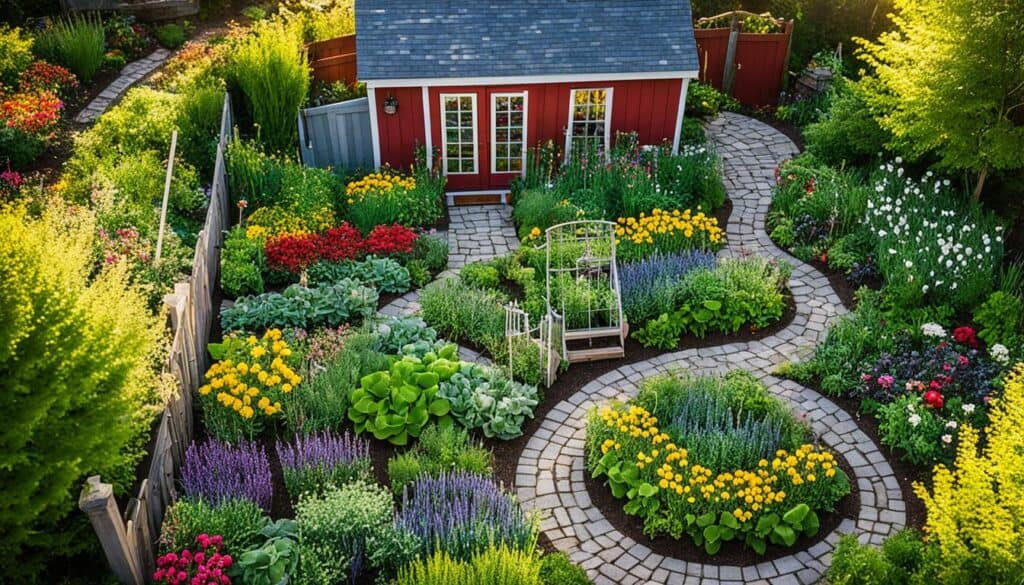Did you know that potager gardens, also known as French kitchen gardens, have been a beloved tradition in France for centuries?
These enchanting gardens, encompassing a harmonious blend of vegetables, flowers, and herbs, have not only captured the hearts of the French but are also gaining popularity worldwide. With their combination of beauty and practicality, potager gardens offer a unique way to transform your backyard into a charming oasis of sustenance and visual appeal.
Key Takeaways:
- Potager gardens, or French kitchen gardens, have a long-standing tradition in France.
- These gardens incorporate a mix of edible plants, flowers, and herbs.
- Potager gardens offer both sustenance and aesthetic appeal.
- They have gained popularity globally due to their unique charm and practicality.
- Creating a potager garden allows you to enjoy the beauty of nature while growing your own food.
What is a Potager Garden?
A potager garden, pronounced po-toe-jay, is a type of garden where vegetables, edible flowers, herbs, and fruit are grown in a visually appealing and sustainable manner. It goes beyond traditional vegetable gardening by incorporating elements of beauty and design. The term potager means “for the pot” and reflects the intention of growing food for consumption while creating a visually pleasing space.
The Appeal of Potager Gardens
Potager gardens have a unique appeal due to their combination of functionality and beauty. Unlike traditional vegetable gardens, potager gardens are designed to be visually appealing and incorporate a variety of plants, including flowers, herbs, and fruits. The French approach to gardening emphasizes the artistic aspect, creating a grown-up fairy world that showcases the beauty of nature.
When you step into a potager garden, you are greeted by a symphony of colors and scents. The meticulously planned arrangements of plants create a sense of harmony and balance, while also providing a bountiful harvest. The intermingling of edible and ornamental plants adds an element of surprise and delight, as you discover not only vegetables but also charming flowers and aromatic herbs that bring a touch of magic to the garden.
One of the key features of potager gardens is their use of geometric patterns and structured layouts. Paths and beds are carefully laid out in symmetrical designs, creating a sense of order and elegance. This attention to detail reflects the French gardening philosophy of creating beauty through precise planning and organization.
Additionally, potager gardens prioritize sustainability and self-sufficiency. By incorporating edible plants into the garden, you can enjoy the fruits of your labor and reduce your reliance on store-bought produce. This eco-friendly approach not only benefits the environment but also promotes a healthier lifestyle.
I believe that potager gardens are a testament to the beauty and ingenuity of French gardening. They combine practicality and aesthetics in a way that is truly inspiring. Walking through a potager garden is like entering a magical realm where nature’s beauty is showcased and delicious, homegrown food is just a few steps away.
Whether you have a small plot of land or a sprawling backyard, you can create your own potager garden and experience the enchanting beauty of French gardening. With careful planning, thoughtful selection of plants, and a touch of creativity, you can transform your outdoor space into a mesmerizing oasis that is both visually stunning and bountiful.
The French Love for Potager Gardens
The tradition of potager gardens runs deep in France, where the French have long embraced the art of kitchen gardening. These gardens have become an integral part of French culture, allowing people to create a harmonious blend of functional food production and exquisite landscaping. The French appreciate both the practical and aesthetic aspects of gardening, understanding the profound connection between their potager gardens and the delicious meals that grace their tables.
French Kitchen Gardening: A Cultural Tradition
The French have a profound appreciation for fresh, homegrown produce, and many continue to cultivate their own food in potager gardens. This centuries-old tradition represents a commitment to self-sufficiency, sustainability, and the preservation of culinary heritage. French potager gardens are a testament to the nation’s deep-rooted love for the land and its bountiful offerings.
“In France, growing a potager garden is not simply a hobby; it is a way of life that celebrates the beauty of nature and the art of good, wholesome food. It is an expression of our love for the land and the joy of nurturing it.” – Jean-Pierre, a passionate French gardener
Functional Beauty: Combining Landscaping and Kitchen Gardening
Potager gardens in France are more than just practical food-producing spaces; they are designed with an artist’s eye. French gardeners carefully arrange a diverse array of vegetables, fruits, herbs, and flowers, creating visually appealing patterns and harmonious color combinations. These gardens showcase the French art of blending aesthetics and functionality, allowing people to enjoy a feast for the eyes as well as the palate.
Cultivating a Connection between Garden and Table
In France, a potager garden is regarded as an extension of the home, bridging the gap between the garden and the kitchen. French gardeners take great pleasure in personally selecting and harvesting their homegrown produce, appreciating the flavors and freshness that only a potager garden can provide. The French recognize that the true essence of a potager garden lies in the intimate connection it fosters between nature’s bounty and the epicurean delights that grace their tables.
How to Start Your Own Potager Garden
Starting your own potager garden is a rewarding endeavor that can be adapted to any backyard space. You can begin by assessing your available space and considering how to incorporate raised beds, large pots, or repurposing existing areas. Raised beds are particularly useful for potager gardens as they provide good soil drainage and allow for efficient use of space. Organic gardening practices can also be integrated into your potager garden to ensure the health of your plants and the environment.
When starting your potager garden, it’s important to evaluate your available space and make the most of it. Here are some steps to get you started:
- Assess your backyard space: Determine the area you have available for your potager garden. Consider the amount of sunlight, soil conditions, and accessibility to water sources.
- Choose your gardening method: Decide whether you prefer raised beds, large pots, or repurposing existing areas. Raised beds are a popular choice for potager gardens as they provide good soil drainage and allow for efficient use of space.
- Prepare the soil: Prior to planting, prepare the soil by removing weeds and enriching it with compost or organic matter. This will help create a fertile environment for your vegetables.
- Select your plants: Choose a variety of vegetables, edible flowers, and herbs that suit your taste and growing conditions. Consider factors such as seasonality, companion planting, and the desired aesthetic appeal of your potager garden.
- Implement organic gardening practices: Embrace organic gardening methods to promote the health of your plants and maintain a sustainable garden. This includes avoiding synthetic pesticides and fertilizers, using compost for nutrient-rich soil, and encouraging beneficial insects.
Remember, a potager garden is not just about functionality but also about creating a visually appealing space. Incorporate elements like trellises, decorative borders, and a mix of colors and textures to enhance the beauty of your garden.
Your potager garden can be a haven for organic vegetable gardening, providing you with a bountiful harvest of fresh and nutritious produce. By starting small and gradually expanding, you can create a thriving potager garden that brings joy, sustainability, and beauty to your backyard.
Designing Your Potager Garden
Design plays a crucial role in creating a captivating potager garden. While there are no strict rules, it’s important to consider the elements that make a potager garden visually appealing. This includes incorporating vertical elements like trellises or climbing plants, using well-defined borders, and achieving a balance between order and whimsy. The design should be curated but not overly controlled, allowing nature to flourish and create a kaleidoscope of colors, shapes, and textures.
Creating Visual Appeal
When designing your potager garden, think about how you can create a visually appealing space that will delight the senses. Consider incorporating the following elements:
- Vertical Elements: Adding trellises or training plants to climb walls or fences can create height and visual interest in your garden. This not only adds a sense of structure but also allows you to maximize your growing space.
- Well-Defined Borders: Use hedges, low walls, or decorative fencing to define the boundaries of your potager garden. This creates a sense of enclosure and adds an element of formality.
- Geometric Patterns: Experiment with geometric designs within your garden layout. Rows of plants, pathways, and raised beds can be arranged in symmetrical or asymmetrical patterns to create a visually pleasing and organized look.
Remember, the key is to strike a balance between order and whimsy. While potager gardens are known for their visually appealing and geometric designs, they should also inspire a sense of delight and playfulness.
I believe that a well-designed potager garden can be a work of art in itself. By carefully considering the placement and arrangement of plants and incorporating elements of visual appeal, you can create a space that is not only productive but also aesthetically pleasing. Allow your creativity to flourish, and let nature guide you in creating a garden that is truly captivating.
Sample Potager Garden Design
To provide some inspiration, here is an example of a potager garden design:
| Section | Plants |
|---|---|
| Center |
|
| Sides |
|
| Edges |
|
This design incorporates vertical elements, well-defined borders, and a mix of edible and ornamental plants to create a visually appealing potager garden. Feel free to modify and adapt this design to suit your own space and preferences.
With careful thought and consideration, you can design a potager garden that not only produces an abundance of fresh vegetables and herbs but also serves as a visually stunning focal point in your backyard.
The Importance of Planning and Harvesting
Planning is a crucial aspect of creating a successful potager garden. By carefully considering the timing and rotation of crops, utilizing seasonality, and planning for harvesting, you can optimize the productivity and beauty of your garden.
When planning your potager garden, it’s important to ensure adequate paths and spacing between plants. This allows for easy access during planting, maintenance, and harvesting, while also preventing soil compaction. By providing enough space for each plant to thrive, you can maximize their productivity and overall health.
Crop rotation is another key element of effective planning. By rotating crops, you can minimize pest and disease issues, maintain soil fertility, and maximize the use of available space. This practice involves changing the location of different plant families each year to prevent the buildup of pests and diseases specific to certain crops.
In addition to edible plants, incorporating non-edible flowers or decorative plants in your potager garden can enhance its visual appeal. These plants not only add splashes of color and texture but also attract beneficial insects, promoting a healthier garden ecosystem.
Benefits of Planning and Harvesting
Proper planning and harvesting in your potager garden offer a range of benefits:
- Maximizes the productivity of your garden by optimizing the use of space and timing of plantings.
- Ensures easy access for maintenance tasks, such as watering, weeding, and harvesting.
- Promotes plant health and reduces the risk of pests and diseases through effective crop rotation.
- Enhances the visual appeal of your garden by incorporating non-edible flowers and decorative plants.
- Provides a diverse and bountiful harvest, allowing you to enjoy fresh and delicious produce from your own backyard.
In summary, planning and harvesting are essential components of creating a thriving potager garden. Through careful consideration of crop timing, rotation, and the incorporation of non-edible plants, you can maximize the productivity and beauty of your garden. So roll up your sleeves, grab your gardening tools, and get ready to enjoy the rewards of your well-designed potager garden!
The Role of Enclosures and Natural Elements
Enclosures and natural elements play a crucial role in creating a thriving potager garden. In traditional French potagers, these elements are used to establish boundaries and structure within the garden while allowing nature to flourish. Enclosures such as walls, fences, and shrubs demarcate different areas and create defined spaces for various plantings.
By incorporating enclosures, you can create a visually appealing and organized potager garden. These structures not only provide a framework for the garden but also serve as a backdrop to showcase the vibrant colors and textures of the plants. They add depth and dimension, enhancing the overall aesthetic appeal of the garden.
Furthermore, these enclosures offer additional benefits by promoting biodiversity. The enclosed spaces create microhabitats that support a diverse range of plant life, including native species. The lush vegetation surrounding the vegetable, fruits, and flowers fills in the gaps, attracting beneficial insects and pollinators, while deterring pests.
To demonstrate the importance of enclosures and natural elements, here is an example of a beautifully designed potager garden:
| Enclosures | Natural Elements |
|---|---|
| A low stone wall | Fruit trees |
| Wrought iron fencing | Wildflower meadow |
| Hedge rows | Hedgerow shrubs |
As you can see, these enclosures not only provide structure and visual interest but also contribute to the overall biodiversity of the garden. The fruit trees attract birds and pollinators, while the wildflower meadow and hedgerow shrubs create habitats for beneficial insects and small wildlife. This harmonious blend of enclosures and natural elements establishes a balanced ecosystem within the potager garden.
By incorporating enclosures and natural elements in your potager garden, you can create a harmonious balance between structure and nature while promoting biodiversity. The interplay of defined spaces and thriving plant life adds depth, visual appeal, and ecological benefits to your garden.
The Beauty of Companion Planting
Companion planting is a fundamental technique in potager gardening that not only enhances the beauty of your garden but also maximizes its functionality. By planting different species together, you can create mutually beneficial relationships that promote the health and productivity of your plants.
One of the key advantages of companion planting is pest control. Some plants naturally repel pests, acting as a natural defense for their neighboring companions. For example, marigolds emit a scent that repels harmful insects, protecting nearby vegetables from infestations. By strategically placing these companion plants throughout your potager garden, you can reduce the need for chemical pesticides and create a healthier ecosystem.
Another benefit of companion planting in potager gardens is the attraction of beneficial insects. Certain plants, such as dill and fennel, attract beneficial insects like ladybugs and lacewings, which are voracious predators of garden pests. These helpful insects act as a natural pest control, keeping your crops free from damage while adding a delightful touch of nature to your garden.
In addition to practical advantages, companion planting also adds aesthetic appeal to your potager garden. By combining plants with different heights, colors, and textures, you can create a visually stunning display. The interplay of vibrant flowers, lush foliage, and diverse shapes will transform your garden into an enchanting oasis for both you and your visitors.
When planning your companion planting scheme, consider the individual needs and compatibility of each plant. Some plant combinations, such as tomatoes and basil, are considered classic companions due to their mutually beneficial relationship. On the other hand, certain plants may inhibit each other’s growth or compete for resources, so it’s important to research and select suitable companions for optimal results.
Companion planting allows for efficient use of available space, enabling you to grow a wider variety of plants in your potager garden. By intermingling crops within the same planting beds, you can maximize productivity and make the most of limited space. This technique also facilitates crop rotation and succession planting, ensuring continuous harvests throughout the growing season.
So, if you’re looking to enhance the beauty and functionality of your potager garden, consider incorporating companion planting. This technique not only promotes a healthier and more sustainable garden but also creates a visually captivating landscape that will leave you and your guests in awe.
Key Benefits of Companion Planting in Potager Gardens:
- Pest control through natural repellents
- Attraction of beneficial insects for natural pest control
- Aesthetic appeal with vibrant colors, textures, and shapes
- Efficient use of space and increased crop diversity
- Facilitation of crop rotation and succession planting
Incorporating Perennial and Annual Plants
When it comes to creating a stunning and productive potager garden, incorporating a mix of perennial and annual plants is key. Perennials, such as herbs and flowers, offer long-lasting benefits and can be strategically interspersed throughout the garden. These plants bring both beauty and functionality, providing a continuous source of fresh ingredients and attracting beneficial pollinators.
“Perennials in a potager garden provide long-lasting benefits, adding beauty and flavor to your dishes year after year.”
The versatility of perennials allows you to create a visually appealing and sustainable garden. From fragrant rosemary bushes to vibrant lavender, herbs not only enhance the aesthetic appeal of your potager garden but also provide a fresh and aromatic touch to your culinary creations. Flowers like marigolds and calendulas not only add pops of color but also act as natural pest deterrents.
On the other hand, annual plants offer a chance to experiment with different varieties each year, adding excitement and diversity to your potager garden. These plants bring a burst of colorful blooms and delicious produce to your garden, giving you an ever-changing landscape and a unique experience with each growing season.
“Annual plants offer a chance to showcase new colors and flavors in your potager garden every year, keeping your garden fresh and exciting.”
When selecting and placing your plants, it’s important to consider their growth habits, including height, spread, and care requirements. This will help you create a well-balanced garden that maximizes both aesthetics and productivity.
Examples of Perennial and Annual Plants for Your Potager Garden:
| Perennial Plants | Annual Plants |
|---|---|
| Rosemary | Basil |
| Thyme | Tomatoes |
| Lavender | Zinnias |
| Marigolds | Marigolds |
| Calendulas | French Marigolds |
By carefully selecting and incorporating a mix of perennial and annual plants in your potager garden, you can achieve a garden that not only delights the eye but also nourishes the body. The combination of long-lasting perennials and ever-changing annuals creates a harmonious balance between beauty and productivity, making your potager garden a true oasis of charm and abundance.
Potager Gardens for Every Space and Budget
Creating a potager garden is a delightful way to bring beauty, sustainability, and fresh produce to your backyard. Whether you have a small urban plot or a sprawling country landscape, potager gardens can be designed to fit any space and budget. With a little creativity and resourcefulness, you can transform your outdoor space into a stunning and productive oasis.
When it comes to designing a potager garden, the possibilities are endless. You can incorporate a variety of elements such as raised beds, containers, trellises, and pathways to maximize your space and create a visually appealing layout. By carefully planning the placement of different plants, you can achieve a harmonious balance between beauty and functionality.
One of the great advantages of potager gardens is their adaptability to different budgets. You don’t need expensive materials or fancy features to create a stunning potager garden. Instead, you can utilize cost-effective alternatives and repurpose existing objects to add charm and character to your space.
For example, consider using natural elements like rocks or salvaged materials to build raised beds or create borders. Not only will this help you save money, but it will also add a touch of rustic elegance to your garden. Additionally, you can take advantage of vertical space by incorporating trellises or hanging baskets, allowing you to grow more plants without taking up valuable ground space.
Another budget-friendly approach is to embrace companion planting. By strategically pairing plants that have symbiotic relationships, you can naturally deter pests and promote healthy growth. For example, planting marigolds alongside your tomatoes can help repel harmful pests, while attracting beneficial insects like bees and butterflies.
Benefits of a Budget-Friendly Potager Garden
- Cost-effective way to grow your own fresh produce
- Creates a visually appealing and inviting outdoor space
- Encourages sustainable gardening practices
- Promotes biodiversity and attracts beneficial insects
- Provides a relaxing and therapeutic environment
“A potager garden is not limited by the size of your wallet, but rather by your imagination and resourcefulness.”
Don’t let a limited budget discourage you from starting your own potager garden. With a little planning, creativity, and a touch of DIY spirit, you can create a beautiful and productive space that will bring joy and abundance to your life.
Conclusion
Creating a potager garden is a magical journey that combines the charm of a beautiful oasis with the sustainability of growing your own food. Inspired by the French tradition, potager gardening offers a delightful fusion of practicality and aesthetics, making it a popular choice for gardeners worldwide.
By carefully planning and designing your potager garden, you can create a space that not only provides sustenance but also brings joy and beauty to your life. Choose a mix of perennial and annual plants to ensure a continuous display of colors and textures throughout the seasons. Consider companion planting to enhance the health of your plants and maximize their productivity.
Embrace sustainable gardening practices by incorporating organic methods, such as using natural pest control methods and composting. This not only benefits your garden but also helps protect the environment. With a little imagination and creativity, you can transform your backyard into a potager garden oasis that nourishes both your body and soul.










Leave a Reply